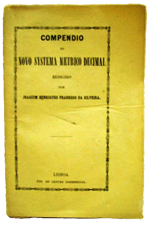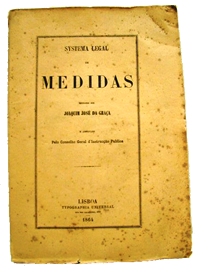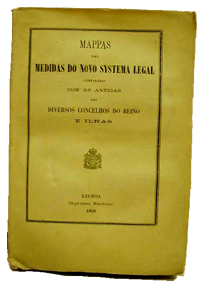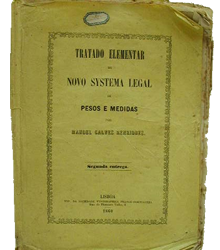
ADOPTION AND PROMOTION OF THE METRIC SYSTEM

Although King João VI determined the adoption of a new system based on the measures of the French metric system (whose fundamental unit was the mètre), with Portuguese terminology, it was never effectively used.
In the 1940s, deputy João Baptista da Silva Lopes raised the issue several times in the Câmara dos Deputados (Chamber of Deputies). After a first attempt in 1843, in 1848 this scholar drafted a new draft law and, to support it, published a work entitled Memória sôbre a reforma dos pesos e medidas em Portugal, segundo o sistema métrico décimal (Memory on the reform of weights and measures in Portugal, according to the decimal metric system).

Finally, the metric system came to be formally adopted by Decree of Queen Maria II of December 13, 1852, following a Report by the Ministers and Secretaries of State of all departments and the positive opinion of the Conselho Geral do Commercio, Agricultura e Manufacturas (General Council of Commerce, Agriculture and Manufacturing).
This law determined the adoption of the “legal meter of France” as the basis of the entire legal system of weights and measures in the country. The various units of the new weights and measures, including multiples and submultiples, would follow the nomenclature of the metric decimal system. The new system would be gradually implemented and should be fully in force 10 years after the publication of the Decree.

The official adoption of the metric system led to the creation of the Comissão Central de Pesos e Medidas (Central Committee on Weights and Measures), under the supervision of the Ministério das Obras Públicas, Comércio e Indústria (Ministry of Public Works, Commerce and Industry). This Commission proposed the creation of the Inspecção Geral dos Pesos e Medidas do Reino (General Inspection of the Weights and Measures of the Kingdom), on which the Estação Central de Aferições (Central Measurement Station) would depend.
During this period (the 50s and 60s of the 19th century), decrees were published on the new standards and metrological control and several publications were published with the aim of promoting and disseminating the metric system.
In 1859 a decree determined the distribution of the new metric standards across the country: the 1st class remaining at the General Inspection of Weights and Measures of the Kingdom, the 2nd class would be sent to the Inspecções de Pesos e Medidas (Weights and Measures Inspections) of each District and the 3rd class would stay with the city councils.

Joaquim Henriques Fradesso da Silveira played a major role in the promotion and dissemination of the metric system in Portugal. He was an artillery officer and Professor at the Escola Politécnica (Polytechnic School) who became the first Inspector Geral dos Pesos e Medidas do Reino (General Inspector of the Weights and Measures of the Kingdom). This military and academic had been in France and Belgium studying the organization of weights and measures and published several works in order to promote the use of the metric system throughout the country.
Fradesso da Silveira was instrumental in the process of gradual adoption and use of the Metric System, promoting the collection of old municipal standards and replacing them with standards of the “new” system and writing various publications with the aim of disseminating and promoting this system.